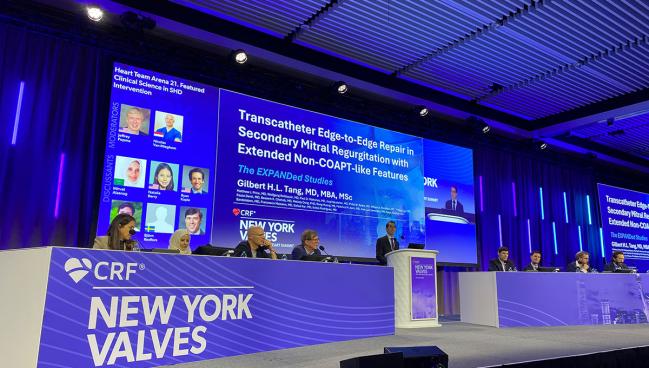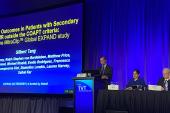MitraClip Safe and Effective in Non-COAPT-Like Patients: EXPANDed
The data indicate it’s worth a shot to try TEER in many with secondary MR, but clinical judgement is critical.

NEW YORK, NY—More postmarket registry data confirm the safety and efficacy of mitral transcatheter edge-to-edge repair (M-TEER) with MitraClip (Abbott) in patients with secondary mitral regurgitation (MR) who fall outside of the COAPT study inclusion criteria.
Presenting new findings from the pooled EXPANDed studies last week at New York Valves 2025, Gilbert H.L. Tang, MD (Mount Sinai Health System, New York, NY), showed similar rates of mortality and heart failure hospitalization at 1 year in patients who would have met the entry criteria for the landmark COAPT trial and those who would not have. Both groups achieved significant reductions in MR.
“Non-COAPT-like patients experience similar improvements in functional status, so you’re not just doing TEER for the sake of doing TEER—trying to reduce the MR. They actually functionally seem to also benefit similarly to the COAPT-like patients,” Tang said. “M-TEER may be then perhaps a viable option in select patients with [secondary] MR and advanced heart disease characteristics who might otherwise be turned down for conventional therapy.”
The findings, which were simultaneously published in JACC: Heart Failure, are in line with similar data Tang presented in 2022, but represent more contemporary practice.
Registry Findings
Published in the New England Journal of Medicine in 2018, the randomized COAPT trial formed the basis of an expanded indication for TEER in patients with heart failure with moderate-to-severe functional MR (≥ 3+) despite treatment with optimal medical therapy. The trial was run with strict inclusion criteria: all patients were required to have an LVEF ranging from 20% to 50% and a left ventricular end-systolic dimension (LVESD) ≤ 70 mm.
In 2024, the 505-patient RESHAPE-HF2 trial sparked interest by showing that patients with secondary MR and lower effective regurgitant orifice areas (EROAs) who received M-TEER and guideline-directed medical therapy (GDMT) had fewer heart failure hospitalizations compared with those who received GDMT alone. It was expected to be the “tiebreaker” between COAPT and MITRA-FR, with the latter failing to show a benefit of MitraClip over GDMT alone.
However, due to variations in patient populations between the three trials, the field has remained conflicted.
Both patient groups had similar rates of comorbidities, with about two-thirds each having a history of heart failure hospitalizations within the prior year and three-quarters each classified as having NYHA class III/IV symptoms. Compared with the COAPT-like patients, non-COAPT-like patients had larger LV end-diastolic volumes (183 vs 22 mL) and EROAs (0.33 vs 0.36 cm²) and greater systolic PAP (48.1 vs 65.7 mm Hg).
Procedural outcomes were similar in the two study groups, with a mean of one clip implanted per patient. Both 30-day and 1-year mortality and heart failure hospitalizations were low and comparable between the two groups. Single leaflet device attachment (SLDA) was numerically higher in the non-COAPT-like patients, but this did not reach statistical significance.
1-year Outcomes
|
|
COAPT-like |
Non-COAPT-like |
|
|
|
(n = 197) |
(n = 81) |
P Value |
|
Death |
14.7% |
14.3% |
0.89 |
|
Heart Failure Hospitalization |
28.1% |
19.5% |
0.21 |
|
MI |
1.0% |
1.3% |
0.99 |
|
Stroke |
0.5% |
0 |
0.99 |
|
Mitral Valve Replacement |
3.1% |
3.9% |
0.72 |
|
SLDA |
0.5% |
2.6% |
0.2 |
|
Device Embolization |
0 |
0 |
n/a |
|
Leaflet Damage |
0 |
1.3% |
0.3 |
Both groups achieved significant MR reductions, with about 90% in each arm reporting MR ≤ 1+ at 1 year (P < 0.001 for both). Quality of life, too, was improved across the board with increases in the Kansas City Cardiomyopathy Questionnaire overall summary score of 22 and 16 points recorded for COAPT-like and non-COAPT-like patients, respectively (P < 0.01 for both).
The researchers found no associations between LVEF, LVESD, or systolic PAP and the risk for either all-cause mortality or heart failure hospitalization.
Notably, Tang highlighted, the non-COAPT-like group had roughly half the number of heart failure hospitalizations compared with the device arm in the MITRA-FR trial (19.5% vs 47.4%).
‘Expand the Borders’
Session co-chair Jeffrey Popma, MD (Cardiovascular Research Foundation, New York, NY), said these new data are “challenging the paradigm” of current practice. “We’re all obligated now to expand the borders of [COAPT],” he said, questioning whether these new data would mean that physicians could expect good results in patients who fall outside the COAPT criteria.
Tang believes the study findings can help advocate for M-TEER in patients who’ve already tried GDMT and either aren’t responding or aren’t able to tolerate the side effects.
“Remember, M-TEER is extremely safe,” he said, adding that it’s worth a try, even it if means not deploying the device due to bad results. “If you can, I don’t see there’s a downside to it.” The improvement in MR with the procedure might even allow physicians to uptitrate medical therapy so that GDMT is better optimized, he added.
Calling for a larger study in this “very heterogeneous” group of secondary MR patients, Tang said this needs a closer look in an all-comers population to have clearer guidance.
“That’s intuitive because it goes with what we see in practice,” panelist John Saxon, MD (University of Virginia, Charlottesville), said. “We offer these patients therapies, and we see them getting better. So it confirms what we’re all willing to do.”
Popma asked the panel how they approach “borderline” patients.
“We’re pretty aggressive with making sure they’re as optimized as possible,” responded Ryan Kaple, MD (Hackensack University Medical Center, NJ). “We wait as long as possible when they’re in the hospital, whether it is a balloon pump or an Impella or anything to offload them.” That might include inotropes, time in the CCU, or even a CardioMEMS device. “I still push for an outpatient procedure, so I guess that really is just overall trying to say avoid those salvage cases as best as possible.”
While the research has shown that M-TEER is safe and can be beneficial for many patients, “you still need to be a doctor and actually pick the right patients . . . to see these kinds of results,” stressed Tang.
Yael L. Maxwell is Senior Medical Journalist for TCTMD and Section Editor of TCTMD's Fellows Forum. She served as the inaugural…
Read Full BioSources
Tang GHL, Price MJ, Rottbauer W, et al. Transcatheter edge-to-edge repair in secondary mitral regurgitation with extended non-COAPT-like features: from the EXPANDed studies. JACC Heart Fail. 2025;Epub ahead of print.
Disclosures
- The EXPAND and EXPAND G4 studies were funded and sponsored by Abbott.
- Tang reports receiving speaker’s honoraria and serving as a physician proctor, consultant, advisory board member, TAVR publications committee member, RESTORE study steering committee member, APOLLO trial screening committee member, and IMPACT MR steering committee member for Medtronic; receiving speaker’s honoraria and serving as a physician proctor, consultant, advisory board member, and TRILUMINATE trial anatomic eligibility and publications committee member for Abbott Structural Heart; serving as an advisory board member for Boston Scientific and JenaValve; serving as a consultant and physician screening committee member for Shockwave Medical; serving as a consultant for NeoChord, Peija Medical, and Shenqi Medical Technology; and receiving speaker’s honoraria from Siemens Healthineers.
- Kaple reports receiving consultant fees/honoraria/speaker’s bureau fees from Abbott and Edwards Lifesciences.
- Popma reports holding equity/stock/options in Medtronic.
- Saxon reports consultant fees/honoraria/speaker’s bureau fees from Edwards Lifesciences and Medtronic.






Comments